-
experimental and numerical investigations of composite concrete–steel plate shear walls subjected to axial load
جزئیات بیشتر مقاله- تاریخ ارائه: 1400/08/01
- تاریخ انتشار در تی پی بین: 1400/08/01
- تعداد بازدید: 256
- تعداد پرسش و پاسخ ها: 0
- شماره تماس ژورنال: 982188779475ext.258
this research is presented experimental and numerical investigations of composite concrete-steel plate shear walls under axial loads to predicate the effect of both concrete compressive strength and aspect ratio of the wall on the axial capacity, lateral displacement and axial shortening of the walls. the experimental program includes casting and testing two groups of walls with various aspect ratios. the first group with aspect ratio h/l=1.667 and the second group with aspect ratio h/l=2. each group consists of three composite concrete -steel plate wall with three targets of cube compressive strength of values 39, 54.75 and 63.3 mpa. the tests result obtained that the increase in concrete compressive strength results in increasing the ultimate axial load capacity of the wall. thus, the failure load, the corresponding lateral displacement and the axial shortening increased by increasing the compressive strength and the rate of increase in failure load of the tested walls was about (34.5% , 23.1%) as compressive strength increased from 39 to 63.3 mpa for case of composite wall with aspect ratio h/l=1.667 and h/l=2, respectively. the effect of increasing aspect ratio on the axial load capacity, lateral displacement and axial shortening of the walls was also studied in this study. compared the main performance characteristic of the testing walls, it can be indicated that the walls with aspect ratio equal to (2) failed under lower axial loads as compared with walls with aspect ratio equal to 1.667 ratios by about (5.8, 12, 15.6 %) at compressive strength (39, 54.75, 63.3 mpa), respectively and experienced large flexural deformations. the mode of failure of all walls was characterized by buckling of steel plates as well as cracking and crushing of concrete in the most compressive zone. nonlinear three-dimensional finite element analysis is also used to evaluate the performance of the composite wall, by using abaqus computer program (version 6.13). finite element results were compared with experimental results. the comparison shows good accuracy.
حوزه های تحت پوشش ژورنال
مقالات جدیدترین رویدادها
-
استفاده از تحلیل اهمیت-عملکرد در ارائه الگوی مدیریت خلاقیت سازمانی و ارائه راهکار جهت بهبود
-
بررسی تاثیر ارزش وجوه نقد مازاد بر ساختار سرمایه شرکت های پذیرفته شده در بورس اوراق بهادار تهران
-
بررسی تأثیر سطح افشای ریسک بر قرارداد بدهی شرکت های پذیرفته شده در بورس اوراق بهادار تهران
-
بررسی تأثیر رتبه بندی اعتباری مبتنی بر مدل امتیاز بازار نوظهور بر نقد شوندگی سهام با تأکید بر خصوصی سازی شرکت ها
-
تأثیر آمیخته بازاریابی پوشاک ایرانی بر تصویر ذهنی مشتری پوشاک ایرانی (هاکوپیان)
-
بررسی رفتار ساختمان های بتن آرمه بهسازی شده با دیوارهای برشی آلومینیومی
-
ارزیابی درجه تراکم دانه بندی گسسته و پیوسته سنگدانه ها در حالت دو بعدی
-
بررسی طراحی بهینه و عملکرد لرزه ای میراگرهای ویسکوز الحاقی در نواحی زلزله خیز
-
طرح دعاوی خصوصی از نظر ضمان قهری و ضررو زیان وارد در دادگاه های عمومی
-
بررسی نحوه طراحی و رتبه بندی سایت در سامانه leed و breeam و امکان سنجی آن با مقررات ملی ساختمان در ایران
مقالات جدیدترین ژورنال ها
-
مدیریت و بررسی افسردگی دانش آموزان دختر مقطع متوسطه دوم در دروان کرونا در شهرستان دزفول
-
مدیریت و بررسی خرد سیاسی در اندیشه ی فردوسی در ادب ایران
-
واکاوی و مدیریت توصیفی قلمدان(جاکلیدی)ضریح در موزه آستان قدس رضوی
-
بررسی تاثیر خلاقیت، دانش و انگیزه کارکنان بر پیشنهادات نوآورانه کارکنان ( مورد مطالعه: هتل های 3 و 4 ستاره استان کرمان)
-
بررسی تاثیر کیفیت سیستم های اطلاعاتی بر تصمیم گیری موفق در شرکتهای تولیدی استان اصفهان (مورد مطالعه: مدیران شرکتهای تولیدی استان اصفهان)
-
نقش صله رحم در سلامت جسمی و روحی خانواده با تمرکز بر گزاره های اسلامی
-
بررسی تاثیر یارانه سفر بر توسعه گردشگری؛ مطالعه موردی: گردشگران شهر مشهد مقدس
-
evaluate the use of recycled asphalt pavement (rap) in the construction of roller compacted concret pavement (rcc)
-
the transformation of aesthetics in architecture from traditional to modern architecture: a case study of the yoruba (southwestern) region of nigeria
-
exploring in silico drug design and pharmacokinetics study for identification of potent antidepressant agents


سوال خود را در مورد این مقاله مطرح نمایید :